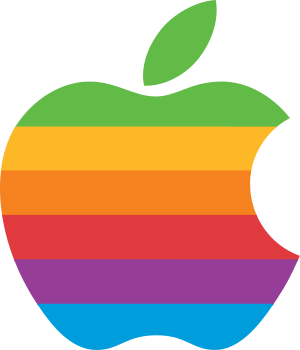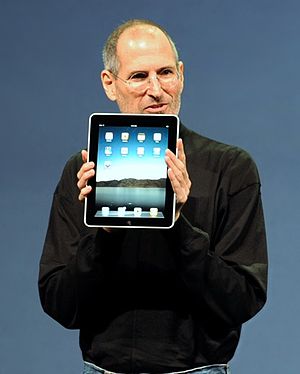
English: The logo for Apple Computer, now Apple Inc.. The design of the logo started in 1977 designed by Rob Janoff with the rainbow color theme used until 1999 when Apple stopped using the rainbow color theme and used a few different color themes for the same design. (Photo credit: Wikipedia)
Once upon a time there was an Apple Computer that used to innovate, generate excitement and create thrills and chills during new product announcements.
Apple still releases new products, but only investor chills remain; the thrills have left the building.
Apple has been running hard towards a wall since it dropped the “Computer” at the end of Apple.
When they decided to become a consumer electronics company—abandoning development of OS X as it was, before it was determined that Macs should work like iPhones and iPads and all things App, they gave up being competitive in the computer hardware department for all intents and purposes.
The last good release of OS X was Snow Leopard. Lion was/is Apple’s Vista. Mountain Lion eclipsed Vista, err, Lion, but nobody cares. The world’s business is run on Windows and Linux servers, not Apple’s. The company that used to advertise fiercely how much better a Mac was than a PC, only is slightly competitive when it comes to small and intermediate-sized business computing environments. This was all OK by Apple until recently when it saw its smart phone market share numbers plummet—something many savvy investors have seen coming for quite some time.
Apple stockholders cheered when the original iPhone was released back in the day. The crowd went wild with giddy anticipation of what their stock portfolios would one day soon look like.
The problem for Apple is what the problem was for Microsoft and what the problem was for Sony, too. When you are on tight, new product release schedules that create pressure internally for sales numbers to be white-hot out of the gate, you are bound to get tackled for a huge loss behind the line of scrimmage. That is because although business environments may change their hardware and OS every three years, consumers are not, at least, anymore.
There are no compelling, must-have features on any iPhone being released. Plus, anyone who wants an iPhone already has one. Apple is reeling from intense, Android competition. Double plus, folks have finally gotten hip to paying the Apple premium for any Apple gadget—iPhone, iPad, iMac (yes, it’s a gadget, too) or iPod. That is, they have come to the realization that it just is not worth it to pay a premium for any device because it says “Apple” on it, anymore.
People want value. Apple used to be about value, but with their abandonment of serious computer operating systems in favor of mobile systems development, it finally is demonstrated how poor an experience can be on a Mac running either Lion or Mountain Lion, when one uses the gadget formerly known as an iMac. I grant you, the iMac screen is beautiful, but when that lovely video display goes out on that gadget, that screen is gone to the shop along with the rest of the computer. This is because that pretty thing is an all-in-one gadget. Call the towers of yesterday ugly if you must, but just plug in another monitor to Mr. Ugly Tower and you are back up and running—same day—just plug… and play!
Have no fear, there will be more new iPhones, new iMacs (without optical drives, mind you!), new iPads, new iPods and new iStuff (I stuff it all under the “didn’t have to be this way but it is” category). When you climb to the top of the heap as fast as Apple has, it is easy to predict their quality of user experience has nowhere to go but down.
If all you need is your iPhone or iPad you didn’t make it this far reading. But since you did, I know every so often you actually need to use a computer to get some work done.
Sadly, it used to be exclusively Apple computers for me, but there is no value to be had in paying extra for things like external optical drives when they should still be included in the actual computer—making me pay for an external drive does not save me money.
The Cloud just isn’t as smooth and fluffy as they’d like you to believe yet.

